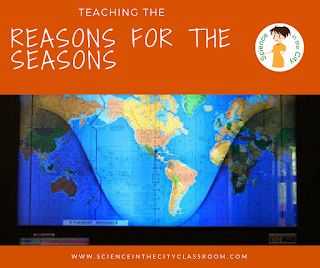I have been shown this video a few times in PD's and graduate courses, but if you haven't seen it, its worth watching. If you have seen it, I think its worth remembering that even when we think we are teaching things clearly, it can be very difficult and confusing for students to grasp.
Nov 19, 2012
Scary Secrets Behind What Our Students Know about Seasons
Did you ever see this video? It shows some common misconceptions, and how much trouble even Harvard graduates have grasping the idea of why we have seasons.
I have been shown this video a few times in PD's and graduate courses, but if you haven't seen it, its worth watching. If you have seen it, I think its worth remembering that even when we think we are teaching things clearly, it can be very difficult and confusing for students to grasp.
Here is the full video http://learner.org/resources/series28.html
I have been shown this video a few times in PD's and graduate courses, but if you haven't seen it, its worth watching. If you have seen it, I think its worth remembering that even when we think we are teaching things clearly, it can be very difficult and confusing for students to grasp.
Blog Giveaway
Interested in a Thanksgiving Giveaway?! Go here to check it out, enter, see the prizes, and try to win one. It will run from Monday through Saturday! There will be 4 winners and you must know that each winner will receive a fantastic prize!
Nov 18, 2012
Misconceptions About the Reasons for the Seasons? Try This
Do your students have a lot of misconceptions about the causes for the seasons? Try this.
Need a seasonal science activity?
Do you do a seasonal/winter/holiday activity with your classes? Sometimes I find it hard to work into an overly busy curriculum, especially with older students. I also am never sure if its better to add to the excitement and chaos, or if its better to maintain as much normalcy as possible. I don't want to 'throw a party' on the day before break, but we also need some recognition of it being a special day. It is not only a day before the break, and perhaps near Christmas, Hanukkah, Kwanzaa, spring break, or summer vacation, but it is probably also near the Winter Solstice, Spring Equinox, or Summer Solstice.This is how I teach about seasons, and celebrate a holiday in science class
Here is a compromise I have worked out. The day before winter break (or somewhere right around there) is usually the winter solstice. Its a great opportunity to talk about why and how the seasons change, how the solstice is celebrated around the world, and to review/introduce a key concept in Earth Science.Now, thanks to technology, we can use a website such as www.daylightmap.com to look at the sunlight on that day all around the world. We can see which areas of the world are experiencing different amounts of sunlight. We can then either set it to different times and dates to see the changes, or we can do this several times of year and see the changes. I like to re-introduce it, since this is an area where there are so many misconceptions and confusions, and its so commonly tested.
We do an activity near the start of school (fall equinox), winter solstice (before winter break), summer solstice (end of school)---you get the idea. Here is the activity that I use for the Winter Solstice
Or, go to www.daylightmap.com and see what creative things you can come up with on your own to help your students understand the real reasons behind the seasons! Please leave a comment with ideas you have :)
Subscribe to:
Posts
(
Atom
)










